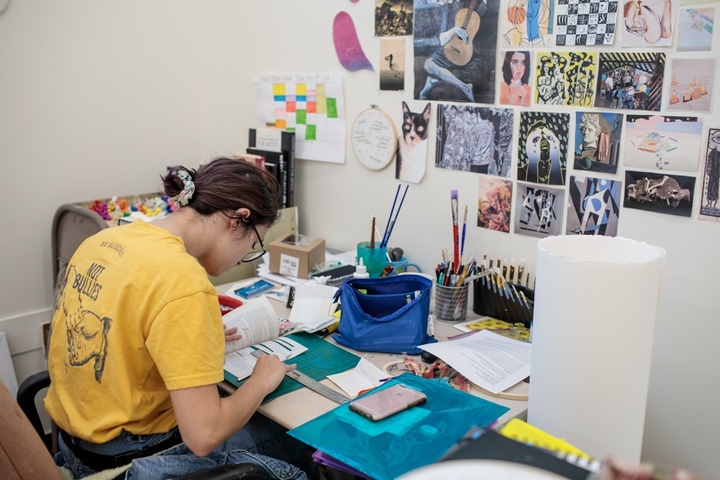Second Majors in Studio Art and Design
Visual thinkers are in demand. No matter how little experience you have in drawing, visual work, or creative fields, our second majors in studio art and design can strengthen every part of your education.
Undergraduates from any school at WashU can add a second major in studio art or design to their existing degree path.
Making visual work and delving into the creative process can enhance your primary area of study. With these skills, you can visualize biology data, draw your scientific ideas, grow fabric from bacteria, design a website for an entrepreneurial effort, work on a creative partnership with medical centers to solve patient challenges, design and bind books, visualize your idea in clay or 3D print it, and much more.
Areas of Study

Second Major in Studio Art
This program integrates a mix of disciplines and technical approaches, including printmaking, photography, sculpture, painting, and time-based + new media. Students will learn to develop their own artistic practice within the contemporary, professional field.

Second Major in Design
This collaborative program combines graphic design, illustration, and interaction design. Students can do a broad overview with no concentration, or concentrate in communication or fashion.
A second major in design or studio art will enable you to create a body of work that showcases your skills as a visual thinker and maker, including specific applications in your areas of interest. For some students, that may take the form of websites, videos, apps, or other projects generated for the screen. For others, this may be two- or three-dimensional artworks, immersive installations, or cutting-edge wearables. Still others may focus on creating business ideas, social impact innovations, or other human-centered projects.
The work in your portfolio will showcase your ability to articulate ideas visually, materially, and spatially, as well as demonstrate your ability to synthesize other areas of study at the university into visual form.
You will participate in at least two portfolio reviews with faculty to help you develop your final body of work. Your portfolio will also help you professionally, whether you are interested in working in the fields of art or design, or in something else altogether.
Why should I pursue a second major in studio art/design?
Second majors in studio art and design provide an opportunity to bring your perspective from your primary area of study to these fields. You’ll discover intersections between your studies, build your portfolio, and participate in the collaborative creative process.
How is the second major different from the studio art/design minor?
While the minors in studio art and design are 15 credits, the second majors are 36 credits—6 of which can be taken outside of the Sam Fox School—allowing you greater depth in your studies.
How is the second major different from the BFA in Studio Art/Communication Design/Fashion Design?
The second major is for non-art/design students who are interested in pursuing a second major in design or studio art, and involves about half of the total credits required for BFA degrees.
How will this major help my future plans?
Integrating a design or art perspective with your own area of study will provide you a unique outlook and skill set as you look to the future. This program provides an opportunity to build your portfolio and develop design skills and collaborative abilities, which are applicable to many fields.
How will I manage the studio classes?
Most studios meet for three hours twice a week conduct critiques, make work, and to learn and use equipment. Students are generally expected to work outside of class for as many hours as they are in class, similar to courses in other schools and departments. Art and design professors are understanding of the nature of your workload, and will help you manage your workload according to your goals.
What classes are required? How many credits?
An overview of the curriculum can be found here. There are 36 credits in the second major, 6 of which can be taken outside of the Sam Fox School. Paths vary, depending on whether you pursue studio art or design and whether you have a concentration.
What are classes like?
Studio classes often have 10-20 students in the class, and most classes have about 3-5 projects. For some studios, students will have three hours of class time to work on projects, usually with breaks allowed by the professor. Because of the intimate class size, studios are very collaborative, allowing students to get input and assistance from peers and professors. Many studios are available to people of any experience level in that area, making them accessible to students in other disciplines.
How do critiques work?
Critiques are one of the most important and influential aspects of studios in the Sam Fox School. While they may seem daunting, critiques are friendly and provide an opportunity to learn how to critically look at visual materials and improve your own work. Because of the collaborative nature of studios, critiques offer a chance for students to support each other, and to grow as designers and artists. Since critiques are unique to the Sam Fox School, professors aim to create an environment that helps you feel comfortable contributing to the classroom discussion.
Do second majors have access to studio space?
Second majors enrolled in two or more 300-level courses in any semester may request studio space or desks. Requests will be considered based on space availability.
How do I declare a second major in studio art/design?
Please review this form for details, or reach out to one of the advisors listed at the top of this page!
“I have always been fascinated with how we communicate with others in the world — both verbally and visually. I’ve chosen to study English and Design and I’ve discovered how the two complement each other so well.”
Select Spring 2022 Courses